 |
|
IN THIS ISSUE:
» Designing An Open-Source Power Inverter (Part 25): Boost Or Buck For Converters That Increase Voltage?
» Exploring Advanced Configurable Logic For Current, Voltage And Power Measurement
» How eFuses Strengthen Power-Path Protection For Cooling Fans In AI Servers
» Focus On Magnetics:
Mythology In Power Magnetics
» Industry Event: APEC 2025
» Power Products
» Industry Event: Sensors Converge 2025
» New on How2Power.com
» Other Top Power News
From the Editor's Desk David G. Morrison
Editor, HOW2POWER TODAY

The word “design” can describe either the activity of creating something, the procedure, or the thing created by that activity. The design articles published in this newsletter typically describe both the procedure and the result as both are necessary in conveying how to accomplish the particular design goal at hand. But some articles are even more about the procedure. This would seem to be the case in Dennis Feucht’s long running series on designing an open-source power inverter, which comes to a conclusion with the publication of part 25 in this issue. In this last part, Dennis further explores the choice of topology for the dc-dc (battery converter) stage, weighing the merits of buck versus boost as it affects the requirements for the transformer and power switches. More than in most power supply design articles I’ve seen, in this series the author has explored design alternatives in order to validate his design choices. Often this meant developing multiple sets of equations and using them to generate tables and graphs of data to compare the results obtained with different circuits, waveforms, component designs and other choices. While this was done in the service of optimizing the inverter to meet the specifications laid out early in the series, and to make the inverter design adaptable to the reader’s needs, it had a broader purpose as well. That was to create a template for designing other types of power converters with power ports that also handle low voltage and high current. While part 25 has links back to all the previous parts in its reference section, we’ll also be posting a dedicated page for this series: “Designing An Open-Source Power Inverter”. Use that page to revisit any past installments, to share the series or to send us your questions or comments on it. Your feedback may inspire topics for discussion in future articles.
|
|

|
HOW2POWER EXCLUSIVE DESIGN ARTICLES 
|
Designing An Open-Source Power Inverter (Part 25): Boost Or Buck For Converters That Increase Voltage?
by Dennis Feucht, Innovatia Laboratories, Cayo, Belize
As this long and winding articles series comes to a conclusion, we have one more point to ponder. In retrospect, was the Volksinverter choice of the CA (boost) power transfer circuit optimal in view of residential inverter convergence to a CP (buck) configuration instead? If we look back at the previous comparisons of the buck and boost circuits, we’ll see that there were some differences between these circuits that complicate the comparisons. The CP-PP circuit we are about to examine is slightly different from the PP and CP-BRG buck circuits previously examined, and is more structurally similar to the CA-PP to allow a more direct comparison of buck versus boost. Read the article…
|
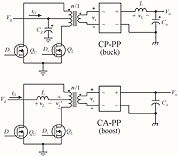
In this analysis, we’ll work through the design
equations that will influence the design of the
transformer in each circuit, compare the current
form factors of the transformer and power
switches, and consider differences in waveforms,
and design power ratios. |

|
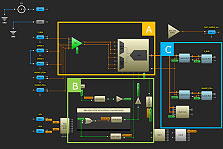
The configurable nature of this device
makes it possible to dynamically adapt to
changing measurement requirements without
any hardware modifications. |
Exploring Advanced Configurable Logic For Current, Voltage And Power Measurement
by Ruslan Tykhovetskyi, Renesas Electronics, Lviv, Ukraine
The increasing complexity of electronic devices often demands precise and reliable monitoring of current, voltage, and power. Beyond capturing instantaneous readings, analyzing how these parameters change over time is crucial for optimizing performance and efficiency. A highly effective approach to this challenge is leveraging configurable logic, which enables the creation of flexible measurement systems tailored to specific applications. The SLG47011V programmable logic chip provides an ideal solution by combining high-speed data processing with functional adaptability, making it a powerful tool for modern engineering applications. In this article, we will explore the advanced capabilities of the SLG47011V for measuring current, voltage, and power, highlighting the importance of leveraging its configurable logic and specialized features to meet the specific requirements of modern monitoring applications. Read the article…
|

How eFuses Strengthen Power-Path Protection For Cooling Fans In AI Servers
by Kshitiz Khatri, Texas Instruments, Karnataka, India
Over the past decade, power levels per rack server have surged from 10 kW or 15 kW to as high as 100 kW, increasing demand for more effective power dissipation. Consequently, fans are transitioning to higher voltage rails (48 V) to accommodate increased power requirements. Historically, eFuses such as the TPS25981 (12 V, 10 A) were used for power-path protection for the 120-W power range. However, the rising power demands of contemporary fans necessitate higher-rated eFuses, such as the TPS1685 (48 V, 20 A), which supports approximately 960 W. This enhancement is crucial for maximizing thermal performance in servers. This article will discuss the application requirements for fan-based cooling in AI server racks and the role of eFuses in protecting the fans against both overcurrent, overvoltage and overtemperature events. Read the article…
|
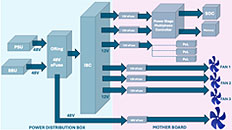
In a generic power delivery network for
a server motherboard with fans running
on 12-V and 48-V power rails, each fan
rail includes an independent eFuse to
protect the power path. |


FOCUS ON MAGNETICS 
Sponsored by Payton Planar Magnetics
A monthly column presenting information on power magnetics design, products, or related technology |
Mythology In Power Magnetics
by Dennis Feucht, Innovatia Laboratories, Cayo, Belize
Magnetic components appear to be so simple—just two parts, a core and some wire wrapped around it. How could that be very complicated? If you ask this question of yourself seriously enough, you begin your own descent into the abyss of magnetics design. As a “recovering magnetaholic,” I have learned that magnetics really is simple, but the path to simplicity is fraught with misleading ideas. Some of these ideas are partially true, but misleading in the ways they are usually expressed; while others are not true at all, though they may be widespread. More importantly, some basic concepts that should be widely known are not. This article is a chat about some of them.
Read the article…
|

 |
 |

 |

|

 |

|

INDUSTRY EVENT
 |
|
APEC 2025: Industry Crafts Vertical Power Delivery Solutions For AI Processors
by David G. Morrison, Editor, How2Power.com
Continuing a trend that that began at last year’s conferences, if not earlier, AI was once again the major topic of discussion at this year’s APEC in Atlanta. Suppliers of power components and power modules spoke on power requirements in AI data centers and showcased their solutions with emphasis on power components for vertical power delivery to GPU and CPU processors. Meanwhile, wide-bandgap SiC and GaN devices were also featured in many APEC exhibits, as they have been for many years now. However, much of the news concerning these devices was packaging related—although one supplier previewed its introduction of a SiC JFET for solid-state circuit breakers, giving the industry another source. Robotics was also a popular theme. This article offers examples of these developments along with other product news from APEC 2025. Read the full story…
|

 |

|

POWER PRODUCTS  |

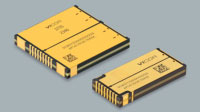
Vicor’s DCM3717 and DCM3735
dc-dc converter modules. |
48-V to 12-V Surface-Mount Power Modules Pack 5 kW/in.3
 Photo: The 750-W, 1000-W and 2000-W nonisolated dc-dc converter modules step down a 40- to 60-V input to a regulated, but adjustable 12-V output for powering legacy 12-V loads in systems with 48-V buses. With their very high power density, they are said to offer a 6x reduction in dc-dc converter size. Photo: The 750-W, 1000-W and 2000-W nonisolated dc-dc converter modules step down a 40- to 60-V input to a regulated, but adjustable 12-V output for powering legacy 12-V loads in systems with 48-V buses. With their very high power density, they are said to offer a 6x reduction in dc-dc converter size.
See the full story…
|

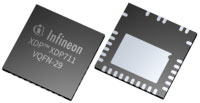
Infineon Technologies’ XDP711-001
hot-swap controller IC. |
48-V Digital Hot-Swap Controller Supports High Power For AI Servers
 Diagram: The controller features fast severe overcurrent detection and shutdown as well as the company’s pulsed SOA current control. Its integrated gate drivers are capable of driving up to eight n-channel power MOSFETs, allowing designs of 4-kW, 6-kW, and 8-kW power delivery boards. Diagram: The controller features fast severe overcurrent detection and shutdown as well as the company’s pulsed SOA current control. Its integrated gate drivers are capable of driving up to eight n-channel power MOSFETs, allowing designs of 4-kW, 6-kW, and 8-kW power delivery boards.
See the full story…
|


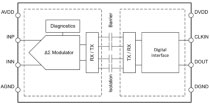
Texas Instruments’ AMC0106M05, AMC0136
and AMC0106M25 modulators. |
Functionally Isolated Modulators Enable Precise Motor Control In Robots
 Photo: As robotics expands to more complex applications — from manufacturing to medicine — the demand is rising for more precise, smaller and high-performance designs to enable the next-generation of robots. These small modulators reduce board space by 50% and deliver higher resolution for accurate and reliable current and voltage sensing. Photo: As robotics expands to more complex applications — from manufacturing to medicine — the demand is rising for more precise, smaller and high-performance designs to enable the next-generation of robots. These small modulators reduce board space by 50% and deliver higher resolution for accurate and reliable current and voltage sensing.
See the full story…
|

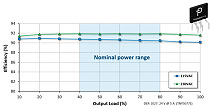
Power Integrations’ TinySwitch-5
offline switcher ICs. |
Fifth-Generation Switcher Family Delivers 175 W And 92% Efficiency In Flybacks
 Diagram: The latest generation of TinySwitch offline switcher ICs delivers higher output power, is more efficient and has enhanced protection. TinySwitch-5 flybacks generate 10-W to 70-W output with PCB cooling alone or up to 190+ W of output with heatsink cooling. Diagram: The latest generation of TinySwitch offline switcher ICs delivers higher output power, is more efficient and has enhanced protection. TinySwitch-5 flybacks generate 10-W to 70-W output with PCB cooling alone or up to 190+ W of output with heatsink cooling.
See the full story…
|

|





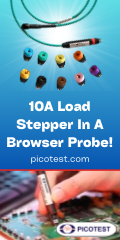
|

 |
 |

 |
 |

INDUSTRY EVENT
 |
|
Sensors Converge Celebrates 40th Anniversary With Extensive Educational Program
The upcoming Sensors Converge, which will be held June 24-26, 2025 at the Santa Clara Convention Center in Santa Clara, Calif. will be the 40th edition of the conference. This year’s program will feature 100+ educational sessions and six in-depth workshops delivered by 100+ of the brightest minds in sensor engineering. Furthermore, the program will be packed with dynamic experiences tailored for technical professionals, including leaders' roundtables, lightning talks, interactive panel discussions, and hands-on workshops. Under the theme, “Driving Smart Sensor Innovation and Delivering Impact,” Sensors Converge 2025 will unite trailblazers from across the electronics ecosystem to explore the technologies and trends shaping the future of smarter, more connected systems. Read the full story…
|

NEW ON HOW2POWER.COM
 |
|
Calendar of Events — Over 350 Listings For 2025
HOW2POWER’s Events Calendar lists selected conferences, tradeshows, workshops and webinars related directly or indirectly to power electronics. Our calendar currently lists over 350 of the electronics industry’s top events for 2025.
Visit this section …
|





 Advanced Energy Industries, a provider of precision power conversion, measurement and control solutions, has announced the recipients of its 2025 STEM Scholarship Program. Advanced Energy Industries, a provider of precision power conversion, measurement and control solutions, has announced the recipients of its 2025 STEM Scholarship Program.
 ZincFive, a provider of nickel-zinc batteries and immediate power solutions, has released its 2025 Data Center Energy Storage Industry Insights Report. ZincFive, a provider of nickel-zinc batteries and immediate power solutions, has released its 2025 Data Center Energy Storage Industry Insights Report.




 Navitas Semiconductor has announced its GaNSense power ICs will power GreatWall’s latest 2.5-kW ultra-high power density dc-dc converter for AI data centers. Navitas Semiconductor has announced its GaNSense power ICs will power GreatWall’s latest 2.5-kW ultra-high power density dc-dc converter for AI data centers.
 Custom Electronics, an Oneonta, NY-based manufacturer of mica paper capacitors and high-voltage assemblies, reflects on its impact on the local region as it celebrates its 60th anniversary. Custom Electronics, an Oneonta, NY-based manufacturer of mica paper capacitors and high-voltage assemblies, reflects on its impact on the local region as it celebrates its 60th anniversary.



ABOUT THIS NEWSLETTER: Thank you for reading HOW2POWER TODAY.
How2Power sends no more than one e-mail per month to registered users. Continuing your subscription ensures you'll receive future newsletters. Manage Your Subscription
©2020 All rights reserved. www.how2power.com
|
|